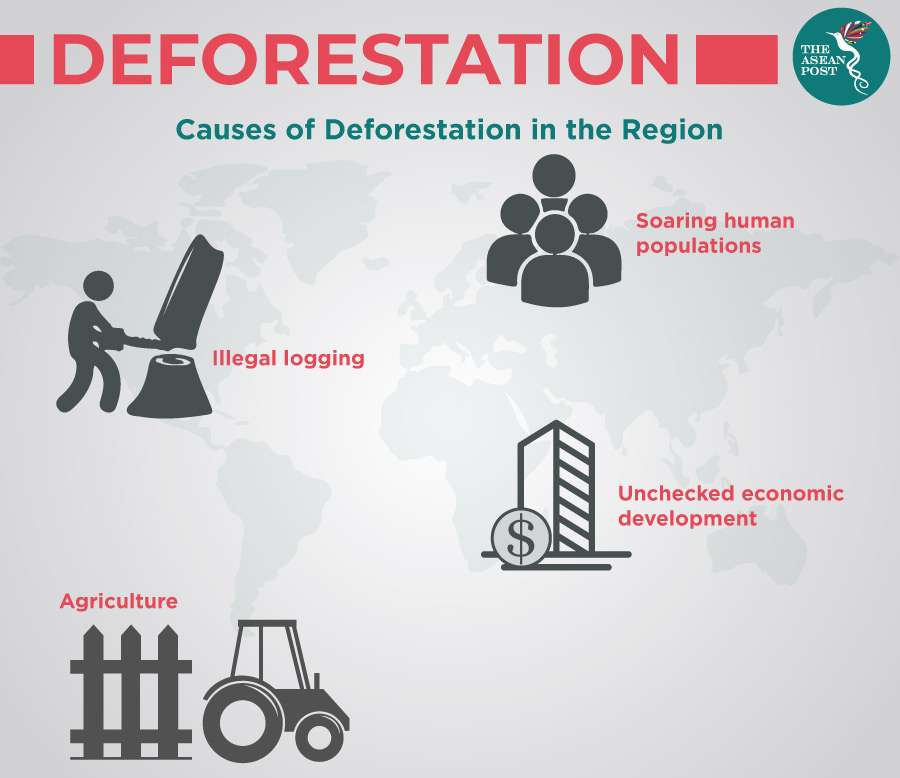Southeast Asia is known for its vast rainforests which constitute about almost 20 percent of forest cover with the richest biodiversity in the world. What the region is also known for is its alarming rate of deforestation. The region has the highest rate of deforestation of any major tropical region followed by Latin America and Africa. It is projected that the region has already lost more than 50 percent of its original forest cover and that some of the primary rainforests in the region will be lost by the year 2022 along with the loss of wildlife habitats. Deforestation is a major problem in the region with Indonesia leading the charts for forests clearing, followed by other hotspots such as Malaysia, Vietnam, Cambodia and Thailand.
Southeast Asia is a global biodiversity hotspot, but with over 600 million people living in the region, the pressures on that biodiversity are severe. Due to the increasing human population, the need for urban spaces has increased, thus governments have taken measures to clear more land in order to fulfil this growing demand.
Another crucial factor of deforestation stems from a rapidly expanding demand followed by unchecked economic development. The forests in Southeast Asia are known to be a rich source of timber suitable for a variety of purposes, seeing as it is filled with tropical rainforests and diverse ecosystems. These forest resources are used as materials in the form of lumber products such as furniture, plywood, paper and pulp, or are used for energy in the form of wood fuel. Due to this, Southeast Asian countries are now faced with the problem of depleting their natural forest resources to meet global demands for timber.
Other causes behind the worrying rate of deforestation include illegal logging and land clearing for agricultural activities. Governments are meant to regulate the production and the trade of timber products within an economy. However, there are always those who violate these laws by harvesting timber from protected areas or logging over the legal limit. Illegal logging endangers these forests that host a colossal number of valuable species and it also lowers prices of timber around the world. This will then affect companies that actually abide by these laws and poorer communities could be left vulnerable to being exploited.
At the rate that this modern-day plague is going, it is obvious as to what the effects of deforestation are. “Deforestation and forest degradation…account for nearly 20 percent of the global greenhouse gas emissions, more than the entire global transportation sector and second only to the energy sector,” the UN REDD programme (United Nations Collaborative Program on Reducing Emissions from Deforestation and Forest Degradation in Developing Countries) reported.

What has ASEAN done and is currently doing to manage this issue at hand?
In an e-mail correspondence with The ASEAN Post, Serina Abdul Rahman, Visiting Fellow of the ISEAS – Yusof Ishak Institute, stated that “ASEAN nations have distinct and different ways of managing their forests – independent of ASEAN as an organisation. Most manage their forests through a forestry department – often at the expense of indigenous folk who might not have the paperwork to lay claim to their ancestral land.”
She added that there is an ASEAN Agreement on the Conservation of Nature and Natural Resources, “but it was never formally agreed and enforced – overtaken by the CBD (Convention on Biological Diversity) which was ratified by all ASEAN countries. ASEAN is now a party to the CBD – which means technically it should agree to a target of at least 17 percent of protected inland areas by 2020. This figure is said to have already been exceeded by most of the ASEAN countries (except Singapore, Vietnam). Individual countries in ASEAN have pledged to establish systems of protected areas.”
In terms of what ASEAN is currently doing to address the issue, she mentioned that the members have committed to the SDG (Sustainable Development Goals) and the UN Framework Convention on Climate Change to recognise the importance of forests in mitigating climate change. Some of the countries - Cambodia, Indonesia, Philippines and Vietnam are already REDD+ (Reducing emissions from deforestation and forest degradation and the role of conservation, sustainable management of forests and enhancement of forest carbon stocks in developing countries) partner countries.
To conclude, Serina stated that it is important to monitor how or whether these public commitments and protocol will translate into any real action or movement on the ground, “especially as economics and national development tends to overcome any inclination to conserve biodiversity for the sake of biodiversity alone. To what extent sustainable development principles can truly be implemented in ASEAN will be what we need to look out for and monitor.”
